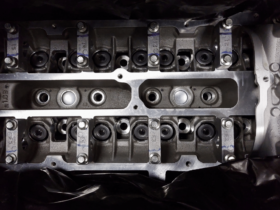Hydraulics are everywhere around us – from heavy construction machinery to the elevator you take at work, the dump truck you see on the streets, and even your car. Hydraulics plays a crucial role in ensuring that your car runs smoothly. If you’re wondering about some of the uses of hydraulics in cars, the hydraulic pump is perhaps the most important.
Major components rely on it in your car to perform crucial functions. Some of these include helping steer your car, braking, and even supporting your car’s weight to ensure a smoother ride and better handling.
First, How Do Hydraulic Systems Work?
While many people have heard of the term ‘hydraulics’ in relation to their cars, most of them have little idea of how hydraulic systems work. In simple terms, hydraulic systems use a pump to push hydraulic fluid through a network of valves to a cylinder to create pressure that is converted back to mechanical energy.
Hydraulic systems are a critical part of powering machinery because of the large amounts of power they can generate and the ease and accuracy of control they provide.
Hydraulics in Car Braking Systems
One of the most critical hydraulic uses in cars is inside the master cylinder. The hydraulic pump in the master brake cylinder is an essential component that pushes the brake fluid through the brake lines to your vehicle’s brake calipers. This provides sufficient pressure or force needed for the calipers to engage the vehicle’s brake discs or pads to ensure a safe and timely stop.
The braking systems in the latest cars need a great amount of applied hydraulic pressure to stop the car, especially when driving at higher speeds and when cornering. The hydraulic pump in your braking system is one of the must-have hydraulic systems required to ensure your vehicle’s smooth performance and functionality every day.
Hydraulics in Power Steering Pumps
If you’ve driven an older vehicle without power steering, you’ve probably experienced how hard it is to turn the steering wheel at lower speeds. The good thing is, modern cars come equipped with power steering that allows easy turning of the vehicle with little effort, even at a complete stop. This is made possible by the hydraulics in the power steering pump.
The power steering fluid that’s regularly topped up as part of your car maintenance schedule is simply hydraulic fluid for the hydraulic pump in the vehicle’s steering system. When you turn the steering wheel, the fluid is pushed to the steering gear via the hydraulic pump. The hydraulic fluid then creates high pressure that helps turn the vehicle.
As time is passing, new technologies are replacing the old tech and in this case I am talking about electric power steering. The electric power steering is adapted by many manufacturers in their small cars, high end premium cars and in some SUVs. Don’t get me wrong, it’s just that electric power steering are being installed in new cars in some cars of all segments. Hydraulics steering are going to stay in automobile applications because of its own uniqueness. Hydraulic and electric power steering has their own pros and cons on real world conditions.
Hydraulics in Car Suspensions
Car suspension systems are critical components that ensure proper handling and control of your vehicle. If you want to fine-tune your suspension for performance racing or off-roading, you can opt for hydraulic suspension. Many car owners opt for this modification as it enables them to have independent dampers for each wheel. Even in electric vehicles, the hydraulic suspension is playing a bigger role in ensuring excellent power handling.
Most hydraulic suspensions are controlled using the main control unit, which is placed inside the vehicle. Each independent damper in the hydraulic suspension system utilizes a small hydraulic pump to apply and reduce pressure at each wheel. These dampers can be turned on and off independently with the flick of a switch in the control unit inside the car. Hydraulic suspension helps raise and lower any part of the car with ease.
Hydraulic Systems are Here to Stay Even though the idea behind hydraulic systems is simple and several years old (it was invented in 1795), it works so well that engineers have only improved the components in hydraulic systems rather than completely replace the idea with an innovation. There’s no doubt that vehicles will continue using hydraulics now and in the future. If you are in search of Diesel truck parts then, check out the prosourcediesel.com site.










Leave a Reply
View Comments